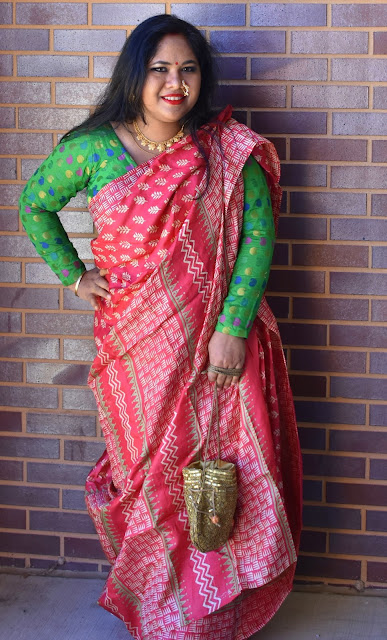“Esho, he Boishakh, Esho Esho. Come, O Boishakh, Come, Come”
– Rabindranath Tagore
Every year, April 14 celebrates the arrival of the Bengali New Year or Poila Boishakh, part of a unique calendar system determined by the seasons. The same day is observed elsewhere as the traditional solar new year and a harvest festival by Hindus and Sikhs, and is known by other names such as Vaisakhi in central and north India, Vishu in Kerala, Puthandu in Tamil Nadu and Rongali Bihu in Assam. While growing up, Poila Boishakh used to be my (Moumita) favourite day of the year as it is the only day when all Bengalis will unwind and celebrate, irrespective of religion, class or caste. Ladies clad in white sarees with red borders, men in dhuti and kurta, take part in the Probhat Pheri processions early in the morning to welcome the first day of the year. On Pohela or Poila Boishakh, a Bengali home is thoroughly scrubbed and cleaned, people bath early in the morning and dress in new clothes. Everyone spends much of the day visiting relatives, friends, and neighbors. Our early memory of a Poila Boishakh day is about wearing new clothes, eating scrumptuous Bengali delicacies all throughout the day and what a fun it was to visit neighborhood businesses to celebrate their Hal Khata or opening of new ledger book for the year. We used to participate in various cultural programmes that usually take place to usher the first day of the Bengali calendar singing Tagore’s songs, not to mention wearing red & white saree and fresh flowers in hair. Here in America, the celebrations are not quite as elaborate but the traditions are kept alive within the Bengali community.
Look of the day:
As mentioned earlier, Poila Boishakh has an intimate connection with red and white saree for a Bong lady. It represents tradition along with festivities and rituals. The colors red and white symbolizes a wierd combination of love, passion, peace, sanctity, and fierceness for me. When planning about this look we thought of skipping the typical red bordered white saree but wanted to keep the essence of red and white colors. Thus the tussar saree with block prints was chosen. It had both essential red and white but yet was unconventional for the day.
I(Moumita) draped the saree in the traditional Bengali আটপৌড়ে style. Full sleeved blouses matches perfectly with this kind of traditional drape and brings in a lot of drama and style. For some extra servings of drama paired simple yet unusual accessories. The gold necklace and kaanbala earrings is complimented by the showstopper Marathi Nathni. Adding the nath makes the whole outfit all the more spectacular and deviates from the usual bengali look. The golden potli bag was a gift from a dear cousin and was a match made in heaven for the outfit.
Before ending this post, wishing all of you a very prosporous and a Happy New Year, শুভ নববর্ষ. May all your dreams come true this year.
I hope you enjoyed the look and found some inspirations. If you have liked this look and feel inspired, then please share this post right now with your friends on Instagram and Facebook. Leave us a comment or two below so that we know our effort was worth it.
Outfit Details:
Saree: Adi Dhakeshwari Bastralaya, Gariahat, Kolkata India
Blouse: Designed by Moumita
Gold Jewelry: N.P. Jewelers, Gariahat, Kolkata, India
Nath: Gehna
Potli Bag, Gift, source unknown.

















Looking beautiful Moumita......And the way you draped the saree in আটপৌরে style is so perfect.Please do a blog how to drape it....
ReplyDeleteThank you Sanchari. Good idea will post sometime soon
DeleteNow you can shop for traditional Indian Paithani Sarees Online and shop from a huge range of pure Sarees like paithani sarees from Pune, Yeola & more at Karmaplace in USA.
ReplyDeleteThe Essence of Bengali New Year
ReplyDeleteGet more information and facts about the essence of the Bengali new year, We are focused to give you information based on facts, which will help you to rethink and rebuild your thoughts.
to get more -http://www.biasedopinion.co.in/pohela_boishakh_the_essence_of_bengali_new_year/